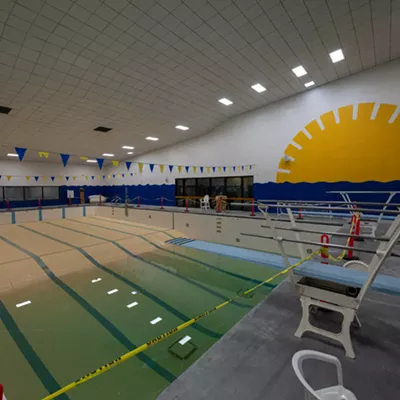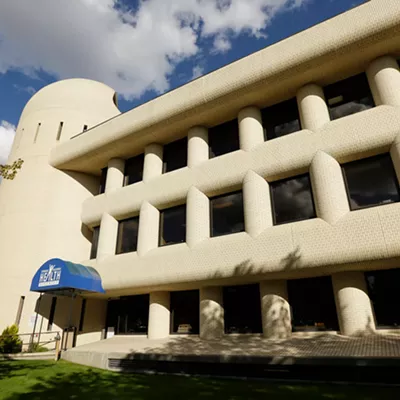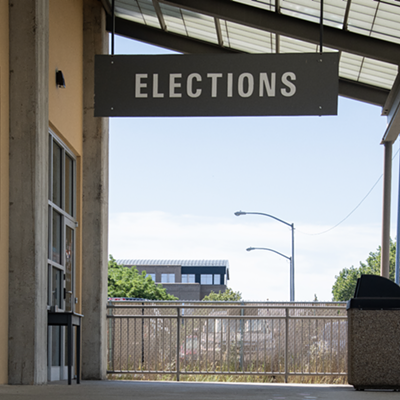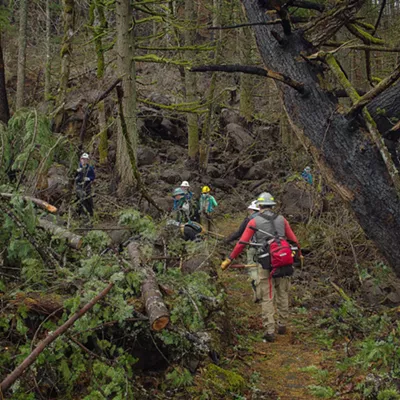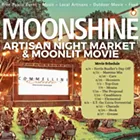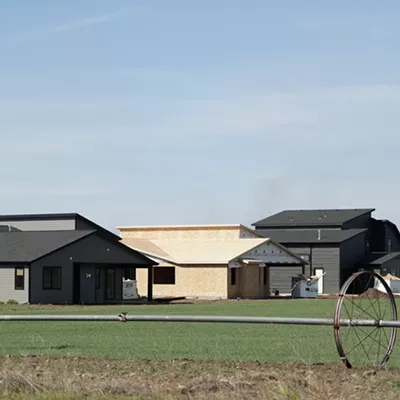The electric engine hums like a spaceship. A digital screen tracks location in real time. Neon lights emit a soft purple glow, like the Mos Eisley cantina in Star Wars.
"I haven't figured out disco mode," the driver jokes from the front. "I've been trying to see if I can find that button."
Even without the Bee Gees, this is a new public transit experience for Spokane. The humming, glowing vehicle isn't a spaceship — it's a bus.
This weekend, the Spokane Transit Authority launches its City Line, an all-electric bus route inspired by bus rapid transit, or BRT, a public transportation system popularized in Latin America and spreading across the world.
City Line features 11 battery-powered, 60-foot-long purple and black buses, each with five doors. They will run along a 6-mile, east-west corridor through downtown Spokane, connecting Browne's Addition to Spokane Community College. The buses will come frequently enough that no traditional bus schedule is necessary: every 15 minutes most hours of the day. (STA plans for 7.5-minute frequencies at peak hours starting in May 2024.)
On opening day, July 15, all rides will be free, and STA will host celebrations with live music, food, games and prizes at five neighborhood stops along the new City Line route. Fares for the City Line will continue to be free for all riders until Labor Day, after which they'll be the standard STA fare of $2 for a two-hour pass and free for people under 18.
A STICKY DOWNTOWN
In 1999, Spokane began reimagining downtown. In their "Plan for a New Downtown," city leaders envisioned a light rail pulsing through the heart of the city. But they realized pretty quickly that building tracks from scratch was far too expensive.
Still, the dream didn't die. After getting input from community members, mapping various routes and considering trams, streetcars and trolleys, the STA settled on a central route populated by buses. By 2011, plans for the City Line began to form as a more realistic compromise to enhance Spokane's transit system.
"We have kind of a hub and spoke system where everything either generates or terminates at the Plaza," says Spokane County Commissioner Al French, a longtime transit advocate who also chairs STA's Planning and Development Committee.
He says the line's east-west route allows easier access to multiple bus routes without having to wait at the main hub.
The main goal was access, says Karl Otterstrom, STA's chief planning and development officer. "[The question] was, 'How do we really access the coolest places in greater downtown and other destinations?'"
A healthy transit system can help feed a healthy downtown. A successful downtown is "sticky," says Emilie Cameron, CEO of Downtown Spokane Partnership.
CITY LINE OPENING DAY CELEBRATION
Sat, July 15 from 11 am-2 pm, free & all ages
The first day of the City Line will have five events along its route, in Browne's Addition, Downtown, the University District, Mission Park and Chief Garry Park. More info at spokanetransit.com/cityline.
A "sticky" area is a place where people can come frequently and stay a long time. An easy-to-use public transit system that connects lots of places — like college campuses, the MAC and Riverfront Park — could help bring commuters and tourists downtown, and opens up more of the city each workday or for a night out.
It was also important that the STA delivered a service "that was not just another bus route," Otterstrom says. The buses would provide more robust service, running more frequently than typical buses with a slightly different payment system and a specialized route. At a glance, the public needed to be able to recognize which vehicles were part of the rapid transit system.
Development on the route began in 2015. The project received some funding from the Federal Transit Administration's grant programs, but this primary revenue stream for the transit system was at risk of being significantly cut.
In 2019, STA was able to secure $53.4 million from the FTA's Small Starts Allocation, which funded over half of the City Line's $92.2 million budget. (The project ended up about $10 million under budget.) This was a huge success for the agency, but more obstacles were yet to come.
With the pandemic, supply chain issues and labor shortages delayed projects across almost every industry, especially transit. The City Line, which was initially projected to open in 2021, was pushed back a couple years.
But in 2020, construction on the City Line stations began, harkening the much-anticipated emergence of bus rapid transit in the Inland Northwest.
10,000 HOURS
This year, Spokanites may have noticed the black and purple buses driving around along their future routes, but without passengers.
Since January, STA has spent 10,000 hours testing and readying the line so that the route would be able to run from its launch with as few issues as possible, says Carly Cortright, STA's spokesperson.
Each City Line bus has new amenities to provide a different type of transit experience. The buses are 20 feet longer than typical coaches, with three doors on the right and two on the left to speed up the boarding process, which can happen on either side depending on the location of the station. Digital screens in the bus give real time information about what stops are next, and each station gives updated info on when the next bus is coming.
STA tested these computer systems over six months for accuracy, says Cortright, as well as resiliency in extreme cold and hot weather.
Additionally, the buses are fully electric. STA spent many training hours to determine how many times a bus could drive through the route before needing to charge, as well as how long it would need to power up before returning to the route.
At the new City Line stations, the buses will line up exactly with the platforms, eliminating the need to lower, or "kneel" the bus for anyone boarding. But the buses will have to kneel at the downtown transit plaza. Cortright says they found issues with the bus ramps and kneeling systems that they wouldn't have known before launch without testing.
With all of these innovations, the group of 10 operators who tested the buses, nicknamed City Line's Team One, needed time to become accustomed to the new buses and technology.
"The new thing that we're getting used to is the left side doors," says Jabriel Pumarejo, part of Team One. "Imagine writing with your left hand. Can you write with your left? No? But eventually? It's just a matter of opening your brain up to what's there."
Pumarejo thinks the adjustment period is totally worth it for the drivers.
"STA getting these buses — it's like Cadillacs for the operators," he says.
Yet finding people to navigate this new fleet has proven difficult as a nationwide bus driver shortage touches Spokane. Not enough bus drivers means the City Line can't initially run every 7.5 minutes as planned. But Cortright says the agency is hiring more people than the national average and expects the rapid transit system to be running at full steam by next summer.
Perhaps the most important part of a long buildup — even a decade-long buildup — is the time an agency has to put toward educating the public about a new service. STA wants the City Line to not be intertwined only with downtown, but with people's lives.
STA worked to eliminate as many "intimidation factors" as possible, Cortright says. For example, first-time users may be confused about how to pay, where exactly the bus goes or how to get off at their stop.
With this in mind, the City Line is free for the first few months, letting people learn about rapid transit without needing to pay right away. Also, lots of time and effort went toward beautifying the bus stops so they're easily recognizable. (Read last week's story, "Delighting Alighting Passengers," on Inlander.com for more.)
STA created lots of signage to make payment and boarding understandable. They hosted volunteer riders and asked for feedback. They assigned ambassadors to answer questions about off-board ticketing machines and how to board bikes in the bus itself, among other things, once the City Line begins service.
WHAT'S NEXT?
The City Line isn't going to be the only bus rapid transit system in Spokane. STA is currently applying for grants for another BRT on North Division Street, which will likely occur in conjunction with the completion of the North Spokane Corridor, aka the north-south freeway.
Though the STA is still dealing with hiring issues, Anthony Gill, who runs the urbanist blog Spokane Rising, says that STA has a really strong team.
"If this were another agency or another city, I would have concerns about things like staffing," Gill says. "Spokane Transit has done a really good job because they've done hiring bonuses, they've done retention bonuses, they've kind of kept up with their need for drivers much better than their peer agencies."
Gill doesn't want to see Spokane's transit innovation end with the City Line. He wants to see signal priority added to the City Line's route, something that Cortright says STA is working on with the city.
In addition to making Spokane more accessible, Gill hopes to see the City Line revolutionize Spokane's attitude toward bus rapid transit. To him, that's a primary measure of success.
"To me, it's not as important that a lot of people ride it, although I want that to happen," he says. "It's almost more important that it inspires more people to ride and more people riding in the future with even further investments. I want it to catalyze that change." ♦
WHAT IS BRT?
The best way to think about bus rapid transit (BRT) is as a streetcar or subway system, but with buses instead of train cars. Service is so frequent that there's no need to look up a schedule. Boarding is quick and streamlined with multiple entry points. Real-time information tells you where you are or when the next buses are arriving.
Today, some of the world's best BRTs are in Rio de Janeiro, Brazil; Bogota, Colombia; Guangzhou, China; Guadalajara, Mexico; and Peshawar, Pakistan. Abroad, it often services huge metro areas, but domestically, it's most popular in midsized cities like Cleveland, Ohio; Albuquerque, New Mexico; and Eugene, Oregon.
The first city to gain international attention for BRT was Curitiba, Brazil. Curitiba kept making improvements to its bus transit in the 1970s and '80s, until it developed into the world's first full-grown BRT.
A fully developed BRT has five essential features: bus-only lanes with signal priority, a corridor in the middle of the road, off-board fare collection, turn restrictions at intersections, and buses that board at the same level as the platform.
In many places, using buses and repurposing pre-existing lanes is cheaper than building tracks for railcars, but the system can potentially be as efficient — in 1993, Curitiba's BRT served 1.5 million riders each day, from a metro population of about 2 million.
In 1995, when U.S. officials from the Federal Transit Administration wanted to see BRT for themselves, they visited Curitiba. Stefano Viggiano, the director of Planning and Development of the Eugene-Springfield area's regional transit district, went along.
Thanks to enthusiasm from Viggiano and community stakeholders, Eugene became one of the first American cities to introduce BRT. In 2007, Lane Transit District launched the Emerald Express, called EmX for short, along a corridor connecting downtown Eugene, the University of Oregon and downtown Springfield.
"It was hard," says Cosette Rees, chief customer experience officer for Lane Transit District. "It was even hard for some of us who worked here at LTD to visualize what this was going to look like and to understand what those benefits could be."
LTD used the first 5-mile route as a proof of concept, offering the public a chance to see and experience the new bus system. LTD officers didn't know how the public would react. Tom Schwetz, LTD's current director of Planning and Development, says they set low expectations.
"So we were surprised when within the first couple of months, we were exceeding our 20-year forecasts," Schwetz says.
Today, EmX spans 28 miles in total, carrying an average of 12,000 riders a day.
— ELIZA BILLINGHAM
This article has been changed with the proper spelling of Carly Cortright, and to show that construction on the City Line began in 2020.








